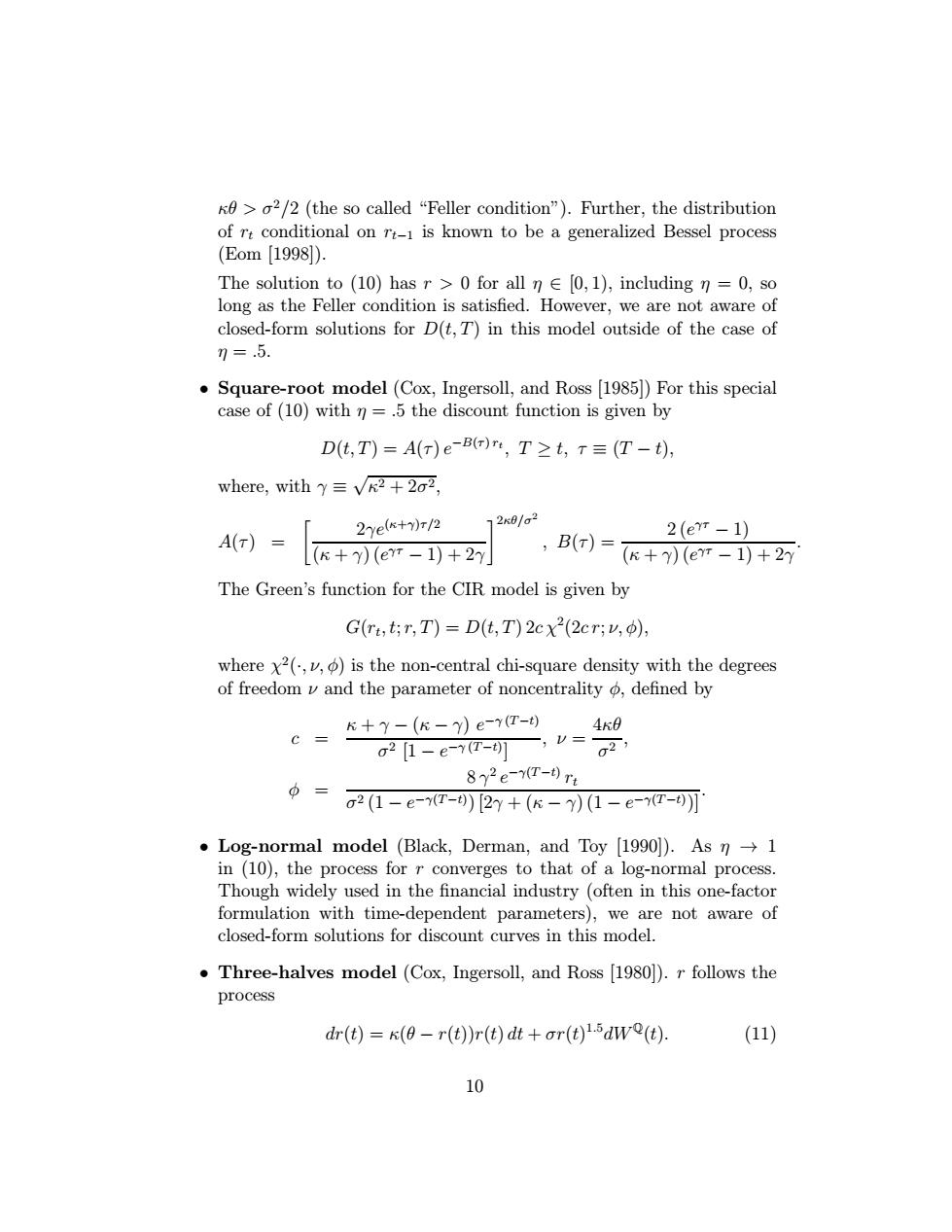正在加载图片...

KO>o2/2 (the so called "Feller condition").Further,the distribution of rt conditional on rt-1 is known to be a generalized Bessel process (Eom[1998). The solution to (10)has r >0 for all n E[0,1),including n =0,so long as the Feller condition is satisfied.However,we are not aware of closed-form solutions for D(t,T)in this model outside of the case of 7=.5. Square-root model (Cox,Ingersoll,and Ross [1985])For this special case of(10)with n=.5 the discount function is given by D(t,T)=A(T)e-B(T)",Tt,T=(T-t), where,with y=VK2 +202, 72x0/a2 A(r)= 2ye(x+7)7/2 2(er-1) (k+y)(er-1)+2yJ ,B(T)=K+)(er-1)+2列 The Green's function for the CIR model is given by G(rt,t;r,T)=D(t,T)2cx2(2cr;v,o), where x2(,v,o)is the non-central chi-square density with the degrees of freedom v and the parameter of noncentrality o,defined by c= K+y-(k-y)e-Y(T-) 4K0 o2[1-e-T--,V= 02, 8y2e-7T-t)rt o2(1-e-T-)[2y+(k-y)(1-e-T-0)】 Log-normal model (Black,Derman,and Toy 1990).As n-1 in (10),the process for r converges to that of a log-normal process. Though widely used in the financial industry (often in this one-factor formulation with time-dependent parameters),we are not aware of closed-form solutions for discount curves in this model. .Three-halves model (Cox,Ingersoll,and Ross [1980).r follows the process dr(t)k(0-r(t))r(t)dt+or(t)'5dWR(t). (11) 10κθ > σ2/2 (the so called “Feller condition”). Further, the distribution of rt conditional on rt−1 is known to be a generalized Bessel process (Eom [1998]). The solution to (10) has r > 0 for all η ∈ [0, 1), including η = 0, so long as the Feller condition is satisfied. However, we are not aware of closed-form solutions for D(t, T) in this model outside of the case of η = .5. • Square-root model (Cox, Ingersoll, and Ross [1985]) For this special case of (10) with η = .5 the discount function is given by D(t, T) = A(τ ) e−B(τ) rt , T ≥ t, τ ≡ (T − t), where, with γ ≡ √κ2 + 2σ2, A(τ ) = 2γe(κ+γ)τ /2 (κ + γ) (eγτ − 1) + 2γ 2κθ/σ2 , B(τ ) = 2 (eγτ − 1) (κ + γ) (eγτ − 1) + 2γ . The Green’s function for the CIR model is given by G(rt, t; r, T) = D(t, T) 2c χ2 (2c r; ν, φ), where χ2(·, ν, φ) is the non-central chi-square density with the degrees of freedom ν and the parameter of noncentrality φ, defined by c = κ + γ − (κ − γ) e−γ (T −t) σ2 [1 − e−γ (T −t)] , ν = 4κθ σ2 , φ = 8 γ2 e−γ(T −t) rt σ2 (1 − e−γ(T −t)) [2γ + (κ − γ) (1 − e−γ(T −t))]. • Log-normal model (Black, Derman, and Toy [1990]). As η → 1 in (10), the process for r converges to that of a log-normal process. Though widely used in the financial industry (often in this one-factor formulation with time-dependent parameters), we are not aware of closed-form solutions for discount curves in this model. • Three-halves model (Cox, Ingersoll, and Ross [1980]). r follows the process dr(t) = κ(θ − r(t))r(t) dt + σr(t) 1.5 dWQ(t). (11) 10